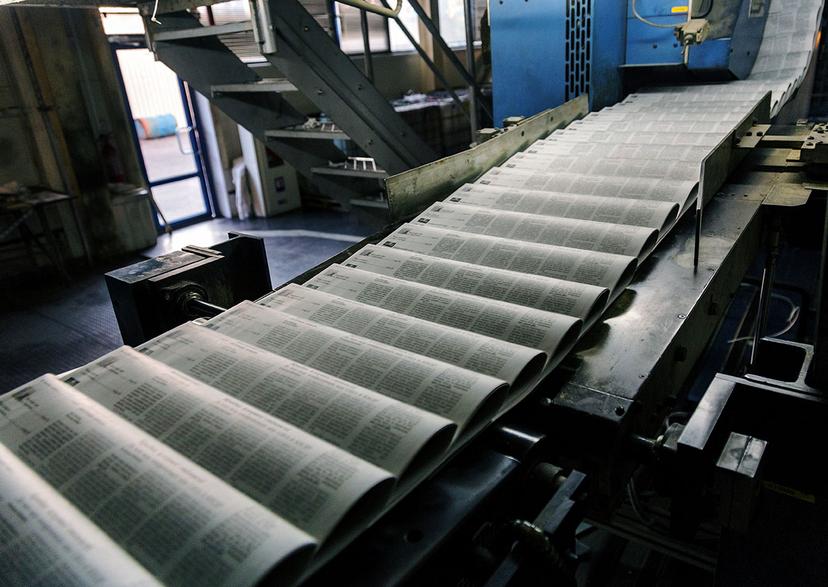Newspapers and Magazines

Background
The first American newspaper, Publick Occurrences Both Foreign and Domestick, appeared in Boston in 1690, but lasted only one issue due to censorship by the British government. The first continuously published newspaper in America was the Boston News-Letter, first published in 1704. The first daily newspaper, the Pennsylvania Evening Post, began publication in 1783. Although he disliked newspapers and suffered cruel abuse from the press, Thomas Jefferson wrote in 1787: "Were it left to me to decide whether we should have a government without newspapers, or newspapers without a government, I should not hesitate a moment to prefer the latter."
Producing these early newspapers was a painstaking process. Every letter for every word had to be hand-selected and placed in a casing in reverse order so they would print correctly when inked. This process, known as typesetting, was done for every page. When all of the words were set, individual sheets of paper were placed under a hand-operated press. Because of the difficulty of obtaining news and the limited technology, these newspapers were small compared with the newspapers of today.
The earliest magazines appeared in Europe in the 1660s. They grew out of academic movements and universities, and they appealed to the highly educated. A decade later, publications with a more general appeal emerged, such as fashion, cooking, and sports magazines. Given the high level of illiteracy in Europe in the 17th century, the earliest magazines appealed to an educated and elite crowd.
The invention of photography in the 1800s increased the appeal of magazines, which often carried interesting and innovative photographs.
As newspapers became larger and circulation increased, one person alone could no longer write, edit, and typeset a page. By the late 19th century, every newspaper employed full-time reporters and editors. New types of presses were developed to increase production, and the Linotype machine had been invented. The Linotype mechanically set the letters so that handset type was no longer necessary. This dramatically decreased the amount of prepress time needed to get a page into print. Newspapers could respond to breaking stories more quickly, and late editions with breaking stories became part of the news world.
Also in the late 19th century, the great newspaper magnates emerged: William Randolph Hearst, Adolph S. Ochs of the New York Times, and Joseph Pulitzer. Each large city had several newspapers. With such intense competition for readership, sensationalism sold as well as news. Newspapers focused on different needs for different readers. Some papers emphasized scandal and gossip; others provided readers with either a liberal or conservative interpretation of the news.
In the United States, magazines have played an important role in entertaining and informing people. Some magazines, such as Time, People, and Newsweek, achieved a nationwide circulation of several million readers. Other more specialized magazines have maintained a more limited circulation while appealing to those with an interest in a certain area, such as sports, economics, or theater.
Computer technology has had a dramatic impact on the newspaper and magazine publishing industries. The Internet allows reporters to research information, confirm stories, and communicate with relevant parties faster than they ever imagined. It also practically eliminates the lag time between the occurrence of a news event and the opportunity for the public to read about it. Reporters and editors now transmit stories by e-mail and the Internet. Computer-fed phototypesetters produce articles and headlines in "cold" (film) type at a rate of 2,000 lines a minute; whole pages are beamed by satellite in a matter of seconds to printing plants half a nation away.
Most newspapers and periodicals maintain extensive Web sites that provide some or all of the information that appears simultaneously in print versions, while some newspapers and magazines (such as Newsweek) now publish solely on the Internet. They offer different levels of access from free to a range of paid subscription models. Today, newspapers also compete with social media, such as Twitter, to break news, and many reporters and journalists maintain Twitter accounts.
Even though many consumers would still rather read hard copies of magazines, those same consumers also use the digital format of the same magazines. These digital products must be interactive, not just a PDF or static formats viewed online. Younger consumers are changing how magazines are consumed simply because they have had less experience with print magazines and prefer them in digital formats. As these consumers grow up and become the major readers of magazines, digital formats are likely to prevail over print.